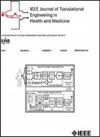通过局部线性模型自动评估尿动力学检查:脊髓损伤个体的验证
IF 3.7
3区 医学
Q2 ENGINEERING, BIOMEDICAL
IEEE Journal of Translational Engineering in Health and Medicine-Jtehm
Pub Date : 2025-02-21
DOI:10.1109/JTEHM.2025.3544486
引用次数: 0
摘要
目的:研究对逼尿肌过度活动(DO)事件进行分类的一致方法和指标,并开发一种根据脊髓损伤(SCI)患者膀胱测量数据进行临床测量计算的自动化可靠方法。方法和步骤:提出了一种两阶段检测DO事件的方法。在第一阶段,使用结合临床定义和已知伪影的阈值标准的局部线性模型检测DO峰值。在第二阶段,提出了一种分割方法,检测每个DO事件的开始和结束时间点,标记DO活动周期。因此,完整的临床测量,包括膀胱顺应性,可以自动估计。该方法在来自SCI患者的77例匿名尿动力学样本(40例DO阳性,37例DO阴性)中进行了开发和测试,其中158例注释了DO事件。结果:在测试数据上,对于患者层面的DO诊断,本文提出的方法准确率达到100%。单个DO事件检测平均精密度为0.94,召回率为0.72。逼尿肌活动期的识别精度为0.86,召回率为0.88。自动膀胱顺应性估计任务表明,与基于线拟合的方法相比,基于点值的方法产生更低的中位绝对误差(MAE), MAE分别为5.20和7.14 ml/cmH2O。最后,将膀胱功能分为正常、低依从性和严重低依从性,该方法的准确率为88%。结论:我们提出的基于临床知识的阈值局部模型拟合,实现了细胞计数数据的准确自动化结果,这将使常规检查的客观评估成为可能。临床和翻译影响声明-本工作提出了一种全自动逼尿肌过度活动诊断和特征提取方法。授权医疗团队一致评估尿动力学研究,同时帮助疾病表征和加强脊髓损伤患者的临床决策。此外,它提供了一个数学上定义的方法来扩展管道到其他人群和标准化临床评估。分类:临床工程,医疗设备和系统。本文章由计算机程序翻译,如有差异,请以英文原文为准。
Automated Evaluation of Urodynamic Examinations Through Local Linear Models: Validation on Spinal Cord Injury Individuals
Objective: Investigating consistent methods and metrics for classifying Detrusor Overactivity (DO) events and developing an automated robust method for clinical measurements calculation from cystometry data in persons with spinal cord injury (SCI).Methods and procedures: A two-stage method for was proposed to detect DO events. In the first stage, DO peaks were detected using local linear models combined with thresholding criteria derived from clinical definitions and known artifacts. In the second stage, a segmentation method was proposed to detect the start and end time points of each DO event, marking the DO activity periods. As a result, complete clinical measurements, including bladder compliance, can be estimated automatically. The method was developed and tested on 77 anonymized urodynamic samples from SCI individuals (40 DO-positive, 37 DO-negative) with 158 annotated DO events.Results: On test data, in terms of the patient-level diagnosis of DO, the proposed method achieved an accuracy of 100%. Individual DO event detection achieved an average precision of 0.94 and recall of 0.72. Detrusor activity period identification showed a precision of 0.86 and a recall of 0.88. The task of automated bladder compliance estimation showed that the point-value-based method yields a lower median absolute error (MAE) compared to the proposed line-fitting-based method, with a MAE of 5.20 and 7.14 ml/cmH2O, respectively. Finally, for classifying bladder function into normal, low and severely low compliance, the proposed method had an accuracy of 88%.Conclusion: Our proposed local model fitting with thresholding based on clinical knowledge, achieved accurate automated results for cytometry data, which will enable objective assessment of routinely performed examinations.Clinical and Translational Impact Statement—This work proposes a fully automated detrusor overactivity diagnosis and feature extraction method. Empowering medical teams to consistently assess urodynamic studies while aiding disease characterization and enhancing clinical decision-making for SCI patients. Furthermore, it provides a mathematically defined method for extending the pipeline to other populations and standardizing clinical assessments.Category: Clinical Engineering, Medical Devices and Systems.
求助全文
通过发布文献求助,成功后即可免费获取论文全文。
去求助
来源期刊

IEEE Journal of Translational Engineering in Health and Medicine-Jtehm
Engineering-Biomedical Engineering
CiteScore
7.40
自引率
2.90%
发文量
65
审稿时长
27 weeks
期刊介绍:
The IEEE Journal of Translational Engineering in Health and Medicine is an open access product that bridges the engineering and clinical worlds, focusing on detailed descriptions of advanced technical solutions to a clinical need along with clinical results and healthcare relevance. The journal provides a platform for state-of-the-art technology directions in the interdisciplinary field of biomedical engineering, embracing engineering, life sciences and medicine. A unique aspect of the journal is its ability to foster a collaboration between physicians and engineers for presenting broad and compelling real world technological and engineering solutions that can be implemented in the interest of improving quality of patient care and treatment outcomes, thereby reducing costs and improving efficiency. The journal provides an active forum for clinical research and relevant state-of the-art technology for members of all the IEEE societies that have an interest in biomedical engineering as well as reaching out directly to physicians and the medical community through the American Medical Association (AMA) and other clinical societies. The scope of the journal includes, but is not limited, to topics on: Medical devices, healthcare delivery systems, global healthcare initiatives, and ICT based services; Technological relevance to healthcare cost reduction; Technology affecting healthcare management, decision-making, and policy; Advanced technical work that is applied to solving specific clinical needs.
 求助内容:
求助内容: 应助结果提醒方式:
应助结果提醒方式:


